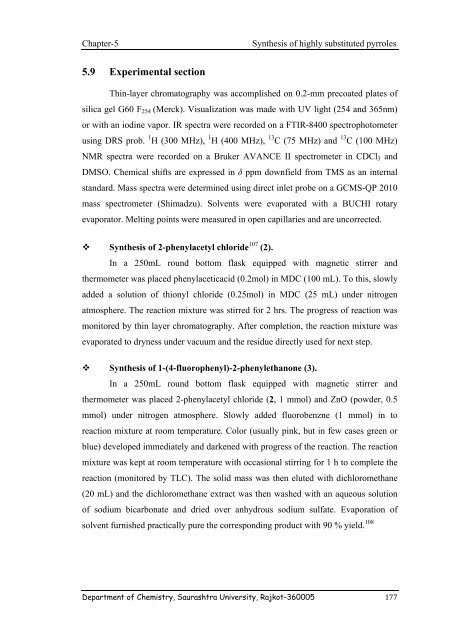Download (6Mb) - Etheses - Saurashtra University
Download (6Mb) - Etheses - Saurashtra University
Download (6Mb) - Etheses - Saurashtra University
You also want an ePaper? Increase the reach of your titles
YUMPU automatically turns print PDFs into web optimized ePapers that Google loves.
Chapter-5<br />
Synthesis of highly substituted pyrroles<br />
5.9 Experimental section<br />
Thin-layer chromatography was accomplished on 0.2-mm precoated plates of<br />
silica gel G60 F 254 (Merck). Visualization was made with UV light (254 and 365nm)<br />
or with an iodine vapor. IR spectra were recorded on a FTIR-8400 spectrophotometer<br />
using DRS prob. 1 H (300 MHz), 1 H (400 MHz), 13 C (75 MHz) and 13 C (100 MHz)<br />
NMR spectra were recorded on a Bruker AVANCE II spectrometer in CDCl 3 and<br />
DMSO. Chemical shifts are expressed in δ ppm downfield from TMS as an internal<br />
standard. Mass spectra were determined using direct inlet probe on a GCMS-QP 2010<br />
mass spectrometer (Shimadzu). Solvents were evaporated with a BUCHI rotary<br />
evaporator. Melting points were measured in open capillaries and are uncorrected.<br />
Synthesis of 2-phenylacetyl chloride 107 (2).<br />
In a 250mL round bottom flask equipped with magnetic stirrer and<br />
thermometer was placed phenylaceticacid (0.2mol) in MDC (100 mL). To this, slowly<br />
added a solution of thionyl chloride (0.25mol) in MDC (25 mL) under nitrogen<br />
atmosphere. The reaction mixture was stirred for 2 hrs. The progress of reaction was<br />
monitored by thin layer chromatography. After completion, the reaction mixture was<br />
evaporated to dryness under vacuum and the residue directly used for next step.<br />
Synthesis of 1-(4-fluorophenyl)-2-phenylethanone (3).<br />
In a 250mL round bottom flask equipped with magnetic stirrer and<br />
thermometer was placed 2-phenylacetyl chloride (2, 1 mmol) and ZnO (powder, 0.5<br />
mmol) under nitrogen atmosphere. Slowly added fluorobenzne (1 mmol) in to<br />
reaction mixture at room temperature. Color (usually pink, but in few cases green or<br />
blue) developed immediately and darkened with progress of the reaction. The reaction<br />
mixture was kept at room temperature with occasional stirring for 1 h to complete the<br />
reaction (monitored by TLC). The solid mass was then eluted with dichloromethane<br />
(20 mL) and the dichloromethane extract was then washed with an aqueous solution<br />
of sodium bicarbonate and dried over anhydrous sodium sulfate. Evaporation of<br />
solvent furnished practically pure the corresponding product with 90 % yield. 108<br />
Department of Chemistry, <strong>Saurashtra</strong> <strong>University</strong>, Rajkot-360005 177

















